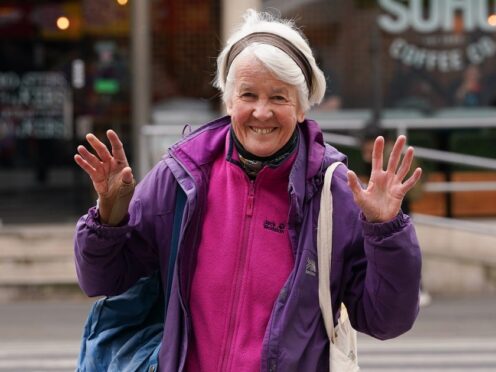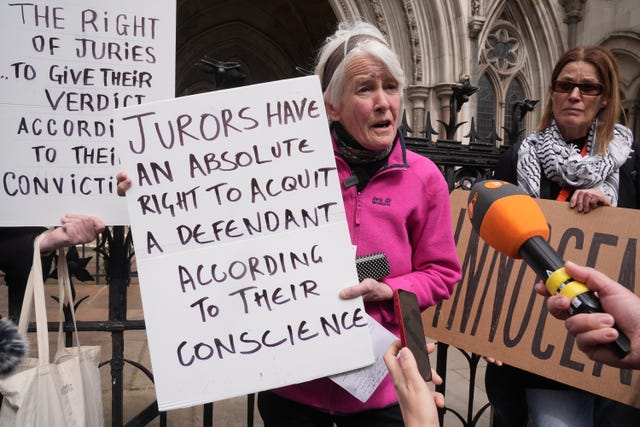
A High Court judge has refused permission for legal action to be taken against a protester for contempt of court, after she was accused of “deliberately targeting” jurors by holding up a sign outside a court ahead of a trial of climate activists.
Trudi Warner was arrested on March 27 last year for holding up a placard outside an entrance used by jurors at Inner London Crown Court before a trial involving members of the climate group Insulate Britain.
The sign read: “Jurors you have an absolute right to acquit a defendant according to your conscience.”
In a hearing last Thursday, lawyers for the Solicitor General Robert Courts, a senior government legal officer, asked the High Court for the green light to proceed with action against Ms Warner for contempt of court due to her “serious interference” with the “administration of justice”.
Barristers for Ms Warner, a retired social worker from Walthamstow, east London, argued her actions do not constitute an offence and that it is not in the public interest to take legal action against her.
Mr Justice Saini said he does not give the Solicitor General permission to pursue proceedings against Ms Warner, as he delivered his judgment at the Royal Courts of Justice on Monday.
He said that Ms Warner “accurately informed potential prospective jurors about one of their legal powers”.
The judge noted that there is a “tension which the law tolerates” between the principle of jury equity – which is the capacity of a jury to return a verdict according to conscience – and their duties in the oaths or affirmations they make, and their obligation to follow judicial directions.
“The proper forum for the Solicitor General to address this concern is Parliament not by way of contempt proceedings,” he said.
“Overall, in my judgment, the claim is based on a mischaracterisation of what Ms Warner did that morning and a failure to recognise that what her placard said outside the court reflects essentially what is regularly read on the Old Bailey plaque by jurors, and what our highest courts recognise as part of our constitutional landscape.”
Ms Warner told the PA news agency she was “relieved”.

She said she was “particularly pleased” that the decision will help others coming up before the courts, before adding: “I just wanted to help.”
Holding the sign which started the events outside the High Court after the hearing, Ms Warner told reporters: “When you see a letter that says government department versus Trudi Warner, and when you have an indictment which is 133 pages, it’s intimidating.”
She went on: “I simply want jurors to know their rights.
“We have heard today that this (the text on the sign) is right, this is correct. We need everybody in the country to know about it.
“The power rests with us.”
Ms Warner also referenced the fact that it was Earth Day and said it is “good” that the judgment has happened today.
Mr Justice Saini said Ms Warner’s conduct does not amount to an “actionable contempt”.
He said: “At no point did Ms Warner assault, threaten, block, accost or impede anyone’s access to the court.”
The judge labelled it “fanciful” to suggest that her conduct fell into a category of contempt which is limited to threatening, intimidatory, abusive conduct, or other forms of harassment.
Regarding the sign she held, Mr Justice Saini said: “The text of the placard… did not implore jurors to act or give an instruction, it simply communicated directly with jurors to summarise the principle of jury equity.”
He added that Ms Warner’s behaviour to members of the public was consistent with information sharing.
“What is striking to me is how little Ms Warner tries to engage with people, to get their attention, or to persuade them of anything,” the judge said.
“All she is concerned with is being in position to show the text of the placard to people, if they chose to look.”
In written submissions, Aidan Eardley KC, representing the Government, said Ms Warner “deliberately targeted” jurors and encouraged them to “approach their task in a particular way”.
Ms Warner’s barristers told the court at the hearing last week that she acted as a “human billboard” to advertise a “vital constitutional, if occasionally used, safeguard against unjust prosecutions”.

Enjoy the convenience of having The Sunday Post delivered as a digital ePaper straight to your smartphone, tablet or computer.
Subscribe for only £5.49 a month and enjoy all the benefits of the printed paper as a digital replica.
Subscribe